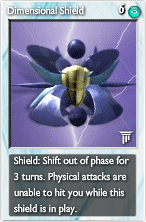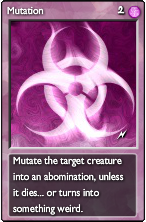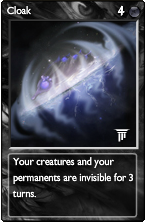Cloak
|
|
Contents
Overview
As an ‘area-of-effect’ permanent, Cloak will conceal a player’s creatures and permanents from being affected by single-target effects for 3 turns. However, the effects of Cloak can be removed if Cloak is directly destroyed by permanent control, or if an AOE creature control spell is used to break the invisibility.
General Use
Quick Facts:
- While affected by Cloak, enemy single-target effects cannot directly target any of a player’s permanents and creatures, excluding Cloak.
- Cloak only lasts three turns before being automatically removed from play.
- AOE spells (Thunderstorm, Plague, etc.) will break Cloak’s invisibility.
- Cloak does not conceal a player’s HP bar, quanta pool, or hand.
Although Cloak is not a perfect protection compared to Quintessence and Enchant Artifact, its general use of obscuring one’s field and protecting all creatures and permanents from nasty abilities shouldn’t be overlooked. For three turns, Cloak will cause all other field creatures and permanents to become invisible except for the Cloak card itself. Thus, in order to directly target a creature or permanent protected from Cloak, one must destroy Cloak first instead. Again, the only cards that are concealed from the opposing player’s view are ones that are on the field; cards within the hand are still shown to both players when they are immediately played, or to the enemy if they view it via Precognition.
In terms of deck building, Cloak can sometimes clog up an enemy’s hand with specialized CC (ex: Antimatter and Reverse Time) and PC (ex: Earthquake and Nymph’s Tears) cards, as the spells will be rendered useless against the invisible field. Moreover, Cloak can serve as a setup for more powerful combos that the opponent might not be able to guess at, as they may not necessarily see or remember what cards a person has played/generated while Cloak is up.
Cloak does have a few notable weaknesses though: a major one being AOE creature control spells. In addition to being removed by PC, Cloak will automatically dissipate when one of the following spells is used to damage multiple creatures:
And once a player’s Cloaked field has been hit by one of the spells, Cloak will disappear, revealing all creatures and permanents back to normal view. Cloak can be meaningless against players with reusable PC options such as Pulverizer and Butterfly Effect as well, as the card advantage given by Cloak becomes short-lived (from 3 turns of having cards being untouched to a single turn of protection). Finally, Cloak is a fairly expensive card; 4 ![]() un-upgraded or 3
un-upgraded or 3 ![]() upped. These costs can be pretty steep in decks that don’t necessarily focus on generating the
upped. These costs can be pretty steep in decks that don’t necessarily focus on generating the ![]() quanta needed, or ones that don’t focus on chaining Cloaks back to back.
quanta needed, or ones that don’t focus on chaining Cloaks back to back.
Having multiple Cloak cards on the field do not do anything besides provide the basic invisibility effect; an AOE CC spell mentioned above can actually removed multiple Cloak cards on a field as well, so players should be conservative on playing the card.
Synergies
 Because Cloak lasts for a maximum of three turns, Dimensional Shield | Phase Shield can synchronize well with the darkness card as they both last the same number of turns. One could theoretically chain both cards at the same time against opponents with limited amounts of permanent control, making it difficult for them to destroy or penetrate through the shield.
Because Cloak lasts for a maximum of three turns, Dimensional Shield | Phase Shield can synchronize well with the darkness card as they both last the same number of turns. One could theoretically chain both cards at the same time against opponents with limited amounts of permanent control, making it difficult for them to destroy or penetrate through the shield.
 Gargoyle | Gargoyle is another popular candidate to combine with Cloak for various reasons. One important reason is that Gargoyle is a solid attacker for 5
Gargoyle | Gargoyle is another popular candidate to combine with Cloak for various reasons. One important reason is that Gargoyle is a solid attacker for 5 ![]() but lacks HP; because of this fact, various spells and abilities ( Holy Light, Paradox, Sniper, etc.) can easily take it out on the first turn unprotected. Cloak however can provide immediate protection for the Gargoyle to use its Stone Form ability and gain the necessary HP to defend against CC.
but lacks HP; because of this fact, various spells and abilities ( Holy Light, Paradox, Sniper, etc.) can easily take it out on the first turn unprotected. Cloak however can provide immediate protection for the Gargoyle to use its Stone Form ability and gain the necessary HP to defend against CC.
 Finally, to really confuse and startle opponents, one could use the controversial Mutation | Improved Mutation card to make several monstrosities on your field without revealing them to the enemy. Because of the randomness of Mutation, only the player with Cloak can witness what type of creatures are produced, while the enemy will have to make while guesses at what the creature is (how much damage they’re capable of doing and what skills they could have). Even with AOE CC cards, an enemy may not want to waste a Rain of Fire on a field of mutant Dragons with high HP or a Plague on a mutated Voodoo Doll.
Finally, to really confuse and startle opponents, one could use the controversial Mutation | Improved Mutation card to make several monstrosities on your field without revealing them to the enemy. Because of the randomness of Mutation, only the player with Cloak can witness what type of creatures are produced, while the enemy will have to make while guesses at what the creature is (how much damage they’re capable of doing and what skills they could have). Even with AOE CC cards, an enemy may not want to waste a Rain of Fire on a field of mutant Dragons with high HP or a Plague on a mutated Voodoo Doll.
Other Cards With Synergy
Other randomizer cards, such as Fate Egg, Fallen Elf, and Nymph’s Tears can also add some surprise to a battle if used correctly and with the right luck. Protect Artifact and Quintessence are also great synergy cards with Cloak; Cloak provides the initial setup for protecting the valued cards, while PA or Quintessence seals the deal.
Conclusion
As a veil of temporary protection, Cloak serves its purpose well and can often ruin decks that don’t have ways to remove the coverage (via PC or AOE CC). If players find themselves fighting against a Cloaked enemy, it should be noted that by carefully observing and remembering what cards they play from their hand, they could discover and prepare for oncoming combinations that are still ‘concealed’ by the Cloak.
Popular Deck

5op 5v2 5v2 5v2 5v2 6qq 6qq 6qq 6qq 6qq 6qq 6qq 6u3 6u3 6u3 6u3 6u3 6u3 711 77f 77f 7ad 7di 7gt 7q5 7q5 7q5 80d 80d 80d


